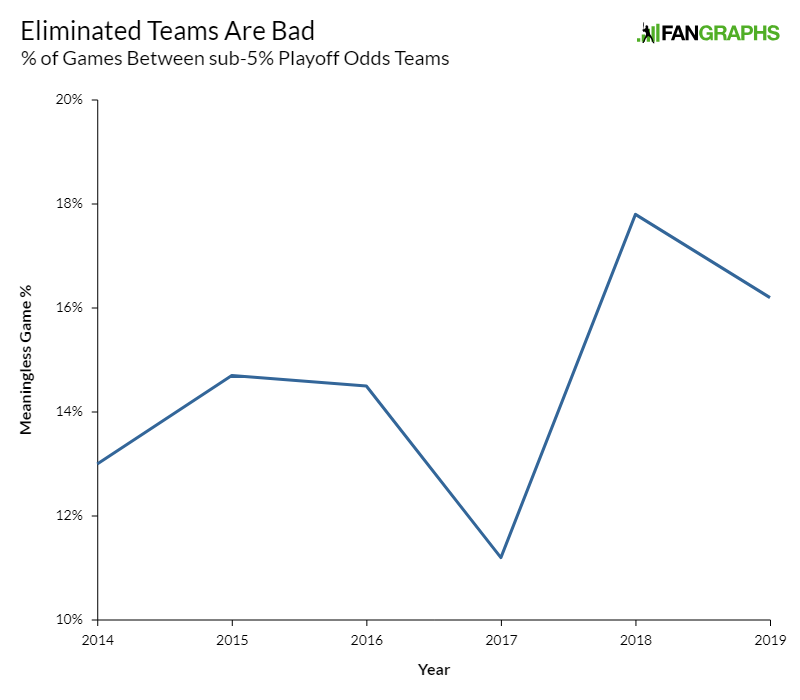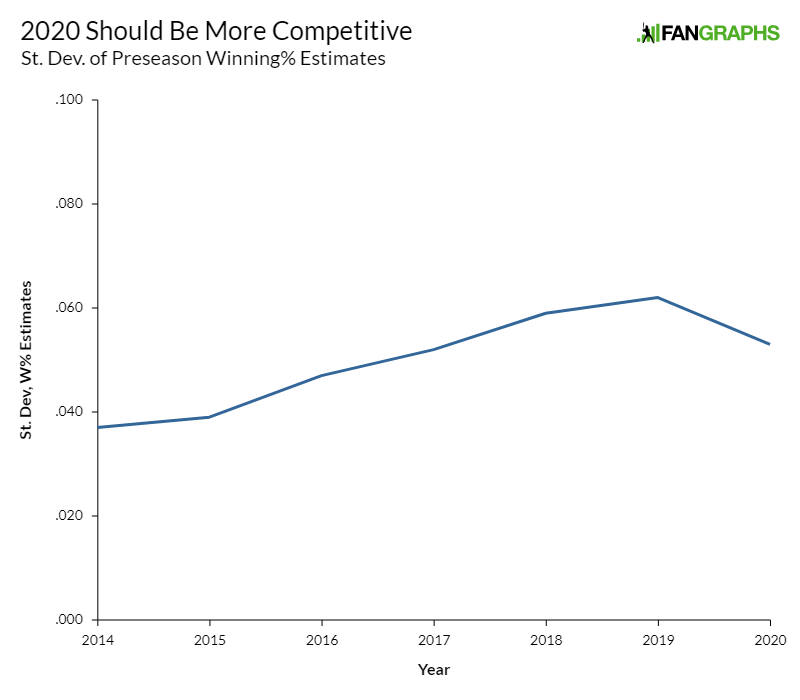2019 Had a Lot of Meaningless Baseball
Have you ever been to a September game between two teams out of playoff contention? I have, and while I like a nice afternoon in the sun as much as anyone, the lack of excitement in the stadium is contagious. Empty seats are demoralizing to fans who want to root for the team — there’s no one around to echo their cheers, so the cheers start to feel perfunctory. If you went to the game to get the thrill of baseball rather than for a pleasant afternoon, you’re often in for a disappointment.
Of course, that feeling isn’t exclusive to September. Last June 14th, for example, the Pirates took on the Marlins in a Friday night game. Per our playoff odds, the Pirates stood a 1.4% chance of reaching postseason play. The Marlins’ odds rounded to 0%, and we have a lot of decimal places to round to. It was only June, but the two teams were already playing out the string. The crowd of 8,340 filled the stadium to roughly one-quarter capacity.
When pundits talk about baseball’s competition problem, these games are the ones they mean. There are bound to be meaningless games throughout the course of the season: a 162-game schedule leaves plenty of time to separate the wheat from the chaff, and by September many teams are simply wrapping things up. Even then though, games don’t have to be completely meaningless; even if the home team is out of it, an exciting visiting team can provide some motivation to fans.
When the streaking Mets visited the Pirates on August 2, for example, PNC Park drew an above-average number of fans for the Friday night clash, even though our playoff odds gave them a scant 0.1% chance to make the playoffs. There was at least still a reason to attend the game — the Mets were interesting, and there’s some measure of joy to be gained from seeing your club take on a contender, and a vicarious thrill to beating them.
So if you want to get to the heart of what baseball’s competitive balance problem does for interest in the game, look to the games played with no stakes. What exactly no stakes means depends on your philosophical bent, and I’ll go into several variations, but first consider this definition: a game with no stakes is one where neither team falls in the 5%-95% playoff odds range at the start of the game.
When the postseason-lock Astros played the Mariners on the last day of the season this year, that game was essentially meaningless. Heck, when they played each other on August 1, our odds gave the Mariners a 0.0% chance at the playoffs and the Astros a 100% chance. Sounds pretty meaningless to me.
With those criteria in mind and a list of every game and each team’s daily playoff odds, we can hunt down the percentage of pointless games in 2019. On first glimpse, the drop from 2018 to 2019 paints an encouraging picture:

But of course, we have no concept of what a scale should be for this. Is 30.9% a lot of meaningless games? It sure sounds like it, but maybe 2018 was more representative. Let’s add in everything since 2014, the first year for which we store daily playoff odds:

Oh. Well that’s not great. 2019 was an improvement on 2018, but 2018 saw a dramatic worsening of the competitive situation. That roughly tracks with Craig Edwards’ earlier research — he noted a spike in competitive imbalance in 2018.
That metric paints with a broad brush. With our dataset, we can refine it. Let’s exclude games where the home team is a playoff lock — from an attendance standpoint, those are suspect choices for “meaningless” games. If your team is playing lights out, you might be marginally less interested in seeing them play the Marlins, but you’re mostly there because your team is great, not because of the opponent. Run it again:

The magnitude has changed a bit, but the rough shape remains the same. The 2019 season saw improvement from 2018, but 2018 was a huge outlier to the previous competitive situation. And it doesn’t seem to be a matter of the way that I’m defining meaningless games.
Let’s vary another term just to prove my point. This time, let’s only look at whether teams have no realistic shot at the playoffs. A game between a playoff lock and a doormat holds no excitement for me, but for the sake of argument, let’s say that good baseball is its own reward. Is that any better?

You could, if you were so inclined, say that the situation isn’t quite so bad. But it was still worse in 2018 and 2019 than it was from 2014-17, and it’s not as though we thought those years were the most competitive in baseball history.
That’s a grim picture, and it agrees with Craig’s earlier analysis. All that remains is to guess whether 2020 will be more like the last two years or the time before it. Without knowing any results, we can’t do the same analysis; but we can at least make an educated guess.
We do have some data about 2020. While rosters aren’t finalized, our Depth Charts projections do give us one data point — each team’s projected 2020 winning percentage. Don’t take these as gospel, because the error bands are meaningful; rosters have yet to be finalized, our playing time estimates can be sharpened further, and we haven’t yet fed ZiPS into the projections.
Despite those limitations, however, we can at least take an educated guess. And that educated guess is incredibly promising: the standard deviation of estimated winning percentages is only .053, which would be the lowest mark in decades. Sounds promising!
There’s reason to be skeptical of this conclusion, however. We’re comparing projections of unknown accuracy to the winning percentages teams actually realized, which doesn’t make much sense. The projections might have a systematic bias towards less variation. To get a better sense of what these projections mean, I looked at the standard deviation of projected winning percentages on the first day of each of the last six seasons. Stop me if you’ve seen this pattern before:

But despite the sameness, there’s good news here. The gap higher in 2018 and 2019 is present in this data as well, and 2020 looks closer to earlier years than to those two outliers. Taking baseball’s competitive landscape back to 2014-17 doesn’t exactly sound like the golden years — there were tanking teams then as well, after all — but it’s a step in the right direction.
We don’t yet know how the 2020 season will play out. Projections are fallible, and they’re merely point estimates anyway. If the past is any indication, however, there should be fewer truly pointless games this year. That’s not quite a chicken in every pot and a playoff race in every city, but it will likely be an improvement on the past two years, and that’s an encouraging thought.
Ben is a writer at FanGraphs. He can be found on Bluesky @benclemens.

No game is meaningless when you can bet on it. Hence why relaxed gambling laws are a big deal to the MLB et al.